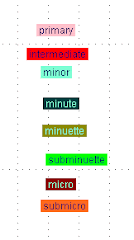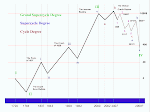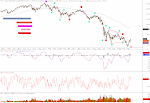
You know the story. The roadrunner zooms by and Wile E. Coyote is hot on his trail. Next thing you know the poor coyote has gone off a cliff. He hangs there as if suspended for awhile before he realizes there is only one way this is going to end -- badly.
Well, the bulls have been fighting gravity for the last several weeks. They have now been pushed off the cliff with Friday's close. After our very brief (as in what 3 days?) double bottom bounce, we have now closed BENEATH the November lows. The last time the SPX closed here was 12 years ago?! So, in honor of this momentous occasion, I thought I would put up a long term chart of the SPX.

I think a picture like this just makes you sit back and wonder, how did we get here? Yes folks, the parabolic rise we have experienced from the late 80s was due to our gov't running the credit spigots overtime. And now we have come to realize that we can't make payments on this mountain of debt we have created. There is only one way out from this mountain of debt, and that is either through default or paying it off. Both are painful. Both are a reality. And no president and congress are going to solve this with 'stimulus', 'bail outs', or other spending activities that will eventually destroy our currency.


With that rant over, let's move on to the charts. I'm currently counting us somewhere in w3 of 5. Depending on how this last piece of w3 goes (we could subdivide some more), it will likely be over with a close above the hourly 8 SMA. Since we have yet to see selling accelerate, I'm expecting it to begin on Monday. However, the bulls have rarely rolled over so easily, so we won't be able to count the current wave complete until we get an hourly close above the 8 SMA, which I expect to occur around the 650 area. If that happens without selling capitulation, then we will likely have an extended wave 5 that will do the job.







Rich,
ReplyDeleteI have a similar target.
http://4.bp.blogspot.com/_vp3HMJGSqug/Sal18PV4XQI/AAAAAAAAAOw/gCJqRk_g2YI/s1600-h/SPX2-28-09.png
I too have a similar count of around Dow 6500.. That should be something like S&P 650.
ReplyDeleteClick on chart below:
http://ross-oregoncoast.blogspot.com/
Rich, would you use log instead the normal scale on the LT SPX chart?
ReplyDeletePedram and Ross, well the market will be the one to let us know if we're right. It rarely makes that easy (we'll likely undershoot or overshoot our targets), so be on your toes and don't be afraid to take some off the table at the end of nice washout day even though we may be above our targets.
ReplyDeleteSteve, you should use both. I used the nominal scale because it emphasized my point the most ;-).
Hi,
ReplyDeleteI stumbled on your blog by accident, I like what you do a lot, and have added you the links of my blog
Visit us if get a chance at
http://markettime.blogspot.com/
Piazzi,
ReplyDeleteYou're welcome here no matter how you got here ;-). Great site yourself btw. I'll keep it on my list of reads.
Rich
Thanks Rich, it sure has more dramatic effect!
ReplyDeleteAlmost forgot, what is the significance or (correlation to wave count) of using "8" period MA versus other number?
Steve,
ReplyDeleteWhen I was looking for an objective way to identify when one wave started and one wave ended, I thought I would start w/ the moving averages, but use fib numbers: 5, 8, 13, etc. What I found was that the 8 SMA worked incredibly well to identify new waves in the 15min and higher time frames. But it needs to be a close above the MA and not just a piercing. I still have to provide some experience to it though. For example, what happens when it closes above and quickly reverses? What about subdivisions, etc. But in the end it is a very useful indicator.
Rich, thanks for sharing, and truly appreciated...Fibo is every where!
ReplyDelete